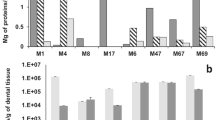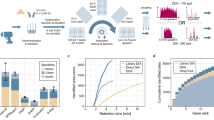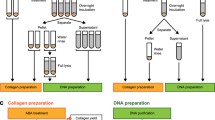Abstract
The ability to retrieve DNA from ancient specimens has been one of the greatest achievements of the past decade, and has opened a totally new field of research with applications in seemingly distant domains such as archeobotany, the molecular phylogeny of extinct genomes, human paleopathology and the genetic of ancient human populations. However, extraction of ancient DNA has often a very low rate of success, prompting researchers to develop screening methods for the selection of promising specimens. With this goal in mind, we studied the amino acid content of nine human bones of ancient origin. We demonstrate that a single HPLC chromatogram is indicative of the integrity of ancient bone proteins. Among five specimens containing amplifiable DNA, four exhibited a protein content similar to that of contemporary bone protein content. Three of the four specimens, from which we were unable to extract any amplifiable DNA, had an amino acid content strikingly different from that of contem-porary bone. A non-parametric statistical test, Kendall's tau, was used to show that protein content and PCR products, are probably correlated (at a 95% confidence level). In addition, the D/L Asp and D/L Glu racemization ratios obtained are indicative of the presence of ancient organic compounds. We propose that protein analysis should be systematically performed in studies where there are many samples in order to select the specimens that are most likely to contain retrievable ancient DNA.
Similar content being viewed by others
References
Higuchi, R., B. Bowman, M. Freiberger, O. Ryder, and A.C. Wilson. (1984) DNA sequences from a quagga, an extinct member of the horse family, Nature, 312, 282–284.
Pääbo, S. (1985) Molecular cloning of ancient Egyptian mummy DNA, Nature, 314, 644–645.
Saiki, R.K., S. Scharf, F. Faloona, K.B. Mullis, G.T. Horn, H.A. Erliich, and A. Arnheim. (1985) Enzymatic amplification of b-globulin genomic sequences and restriction site analysis for diagnostic of sickle cell anemia, Science, 230, 1350–1354.
Thomas, R.H., W. Schaffner, A.C. Wilson, and S. Pääbo (1989) DNA phylogeny of the extinct marsupial wolf, Nature 340, 465–467.
Thomas, W.K., S. Pääbo, F.X. Villablanca, and A.C. Wilson (1990) Spacial and temporal continuity of kangaroo rat populations shown by sequencing mitochondrial DNA from museum specimens, J Mol Evol. 3, 101–112.
Lawlor, D.A., C.D. Dickel, W.W. Hauswirth, and P. Parham (1991) Ancient HLA genes from 7,500-year-old archaeological remains, Nature, 349, 786–788.
Hagelberg, E., S. Quevado, D. Turbon and J.B. Clegg (1994) DNA from ancient Easter islanders, Nature, 369, 25–26.
Stone, A.C. and M. Stoneking (1993) Ancient DNA from a pre-colombian Amerindian population, Am. J. Phys. Anthropol, 92, 463–471.
Horaï, S., R. Kondo, K. Murayama, S. Hayashi, H. Koike, and N. Nakaï (1991) Phylogenetic affiliation of ancient and contemporary humans inferred from mitochondrial DNA, Phil. Trans. R. Soc. Lond B, 333, 409–417.
Rogan, P.K., and J.J. Salvo (1990) Study of nucleic acids isolated from ancient remains, Yearbook Phys. Anthropol, 33, 195–214.
Hagelberg, E. (1994) Ancient DNA studies, Evolutionary Anthropology, 2, 199–207.
Audic, S. and E. Béraud-Colomb (1997) Ancient DNA is thirteen years old, Nature Biotechnology, 15, 855–858.
Béraud-Colomb, E., R. Roubin, J. Martin, N. Maroc, A. Gardeisen, G. Trabuchet, and M. Goossens (1995) Human b-globin gene polymorphisms characterized in DNA extracted from ancient bones 12,000 years old, Am. J. Hum. Genet., 57, 1267–1274.
Pääbo, S., and A.C. Wilson. (1991) Miocene DNA sequences a dream come true? Molecular Evolution, 1, 45–46.
Lindahl, T. (1993) Instability and decay of the primary structure of DNA, Nature, 362, 709–715.
Lindahl, T. (1993) Recovery of antediluvian DNA, Nature, 365, 700
Hedges, S. B. and M. H. Schweitzer (1995) Detecting Dinosaur DNA, Science, 268, 1191.
Richards, M.B., B.C. Sykes and R.E.M. Hedges (1995) Authenticating DNA extracted from ancient skeletal remains, Journal of Archaeological Science, 22, 291–299.
Béraud-Colomb, E., Roubin, R., Martin, J., Maroc, N., Gardeisen, A., Trabuchet, G. and Goossens, M. (1997) Letter to the Editor. Am. J. Hum. Genet., 60, 1002.
Poinar, H.N., M. Höss, J.L. Bada and S. Pääbo. (1996) Amino acid racemization and the preservation of ancient DNA. Science, 272, 864–866.
Höss, M., P. Jaruga, T.H. Zastawny, M. Dizdaroglu and S. Pääbo (1996) DNA damage and DNA sequence retrieval from ancient tissues, Nucleic Acids Research, 24, 1304–1307.
El Mansouri, M., A. El Fouikar and B St Martin. (1996) Correlation between14C ages and aspartic acid racemization at the upper Paleolithic site of the abri Pataud (Dordogne, France), Journal of Archaeological Science, 23, 803–809.
Triffit, J.T. (1980) Fundamental and Clinical Bone Physiology. M.R. Urist Ed., J.B. Lippincott and Co, pp. 45–82.
Bada, J.L. (1970) Marine sediments: dating by racemization of amino acids, Science, 170, 730–732.
Wehmiller, J. F., and P.E. Hare. (1971) Racemization of amino acid in marine sediments. Science, 173, 907–911.
Bada, J.L., E. Mitchell, and B. Kemper. (1983) Aspartic acid racemization in narwhal teeth. Nature, 303, 418–420.
Williams, K.M. and G.G. Smith. (1977) A critical evaluation of the application of amino acid racemization to geochronology and geochemistry, Origins of Life, 8, 91–144.
Matsu'ura, S., and N. Ueta. (1980) Fraction dependent variation of aspartic acid racemization age of fossil bone, Nature, 286, 883–884.
Press, W.H., S.A. Teukolsky, W.T. Vetterling, and B.P. Flannery (1992) Numerical Recipes in C. The art of scientific computing, Cambridge University press, Cambridge, pp. 642–645.
Krings, M., A. Stone, R.W. Schmitz, H. Krainitzki, M. Stoneking and S. Pääbo (1997) Neandertal DNA sequences and the origin of modern humans, Cell, 90, 19–30.
Vandermeersch, B. (1981) Les hommes fossiles de Quafzeh (Israel) Paris: Editions CNRS.
Author information
Authors and Affiliations
Rights and permissions
About this article
Cite this article
Audic, S., El Masouri, M. & Béraud-Colomb, E. The use of protein characteristics to assess the retrievability of ancient DNA from ancient bones. Int. J. Anthropol. 17, 17–26 (2002). https://doi.org/10.1007/BF02447901
Received:
Accepted:
Issue Date:
DOI: https://doi.org/10.1007/BF02447901




